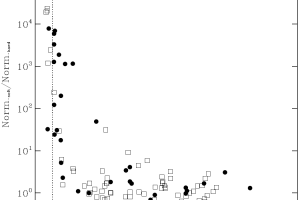Pubblicato su A&A: “CSI 2264: Simultaneous optical and X-ray variability in pre-main sequence stars. I” di M. G. Guarcello

di Mario Giuseppe Guarcello ( segui mguarce)
Osservare come cambia la luce delle stelle nel tempo può essere un hobby interessante, ma in alcuni casi può essere molto di più: una diagnostica nuova e potente per qualcosa che difficilmente può essere osservato in altro modo.
Una classe di stelle in cui lo studio della variabilita’ puo’ essere molto importante e’ quella costituita dalle stelle di pre-sequenza con dischi protoplanetari. Tali stelle sono infatti caratterizzate da fenomeni violenti e fortemente variabili nel tempo, che possono essere osservati ed analizzati direttamente con difficolta’. Ad esempio, la regione interna del disco, distante poche 0.1 UA dalla stella centrale, e’ importantissima per l’accoppiamento tra stella e disco e l’evoluzione del disco stesso. Questa zona non puo’ essere osservata direttamente. Tuttavia, strutture presenti in questa regione del disco possono occultare la stella centrale, assorbendone parte della radiazione, e permettendoci di poterne studiare geometria e composizione. Un altro esempio e’ il processo di accrescimento di gas dal disco alla stella centrale, un processo fortemente variabile ed irregolare, importante per l’evoluzione della stella, ma che non puo’ essere osservato direttamente. Nuovamente, lo studio della variabilita’ puo’ svelarne geometria e proprieta’.
L’articolo recentemente pubblicato su Astronomy & Astrophysics “CSI 2264: Simultaneous optical and X-ray variability in pre-main sequence stars. I: Time resolved spectral analysis during optical dips and accretion bursts in stars with disks” dall’astronomo Mario Giuseppe Guarcello utilizza le curve di luce ottiche (i.e. variazioni durante il tempo della radiazione ottica) delle stelle con dischi protoplanetari osservate con il satellite CoRoT per isolare intervalli di tempo in cui in tali stelle il materiale associato al disco oscura parzialmente la stella centrale o sono osservabili dei brillamenti dovuti all’accrescimento di gas dal disco alla stella. Successivamente, in tali intervalli calcola le proprieta’ ai raggi X, per comprendere varie caratteristiche del materiale circumstellare, quali: la composizione e la natura del materiale che oscura la stella o se l’accrescimento di gas dal disco alla stella avviene tramite un flusso ordinato e persistente o una caduta caotica ed irregolare di materiale. I risultati principali dell’articolo sono:
- Aver osservato che il materiale circumstellare che oscura la stella puo’ assorbire sia la radiazione ottica che quella ai raggi X, e che nelle stelle studiate tale materiale e’ associato al processo di accrescimento
- Aver osservato emissione ai raggi X “soffici” (0.5-1 keV) durante i brillamenti dovuti al processo di accrescimento, ed in due stelle aver potuto stimare che il processo di accrescimento e’ instabile ed irregolare.
Nell’immagine (link) il confronto tra l’emissione osservata ai raggi X soffici e quelli “duri” (1-8 keV) durante i brillamenti di accrescimento o in qualsiasi altro intervallo definito nelle stelle analizzate, che prova un eccesso di emissione soffice nel primo campione rispetto al secondo.
